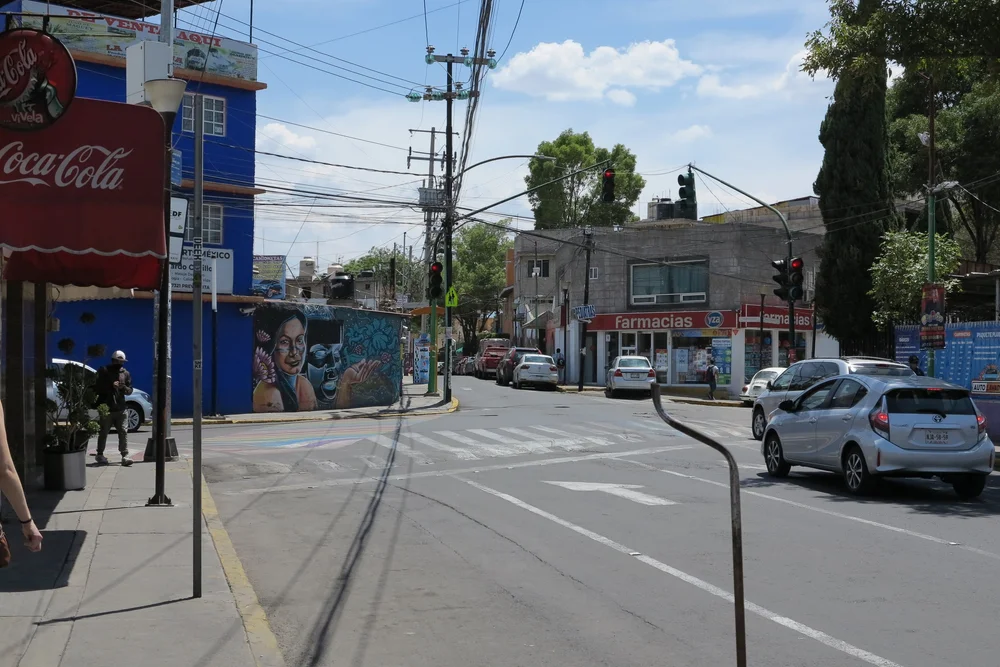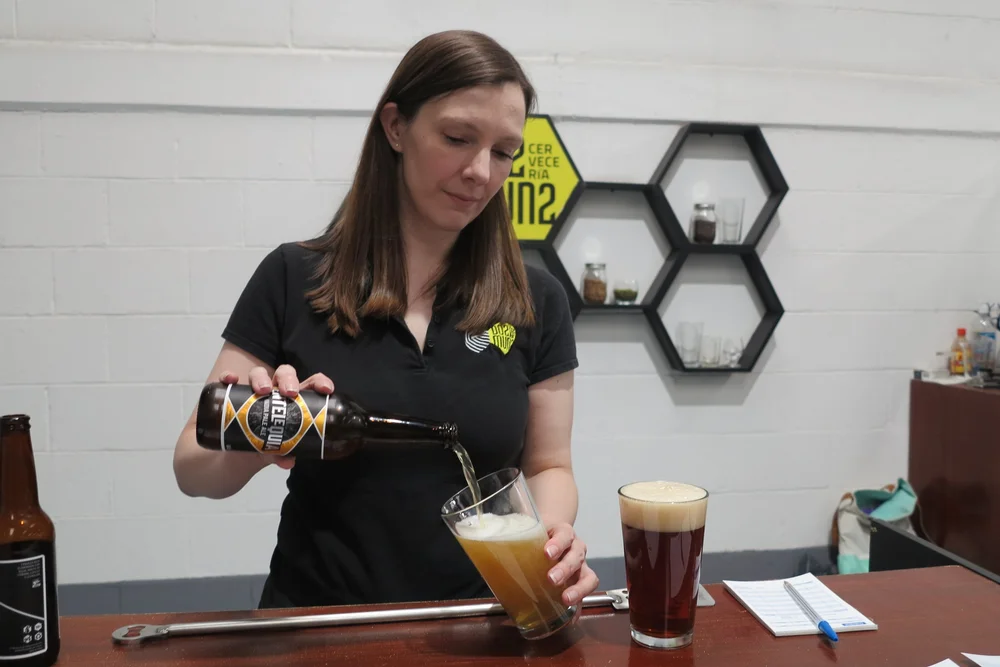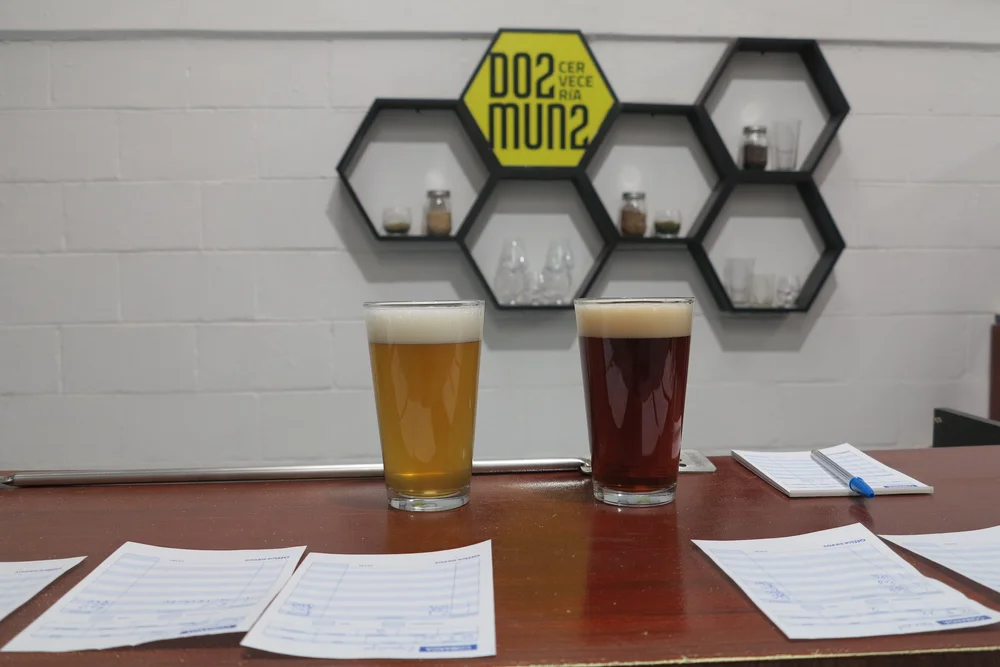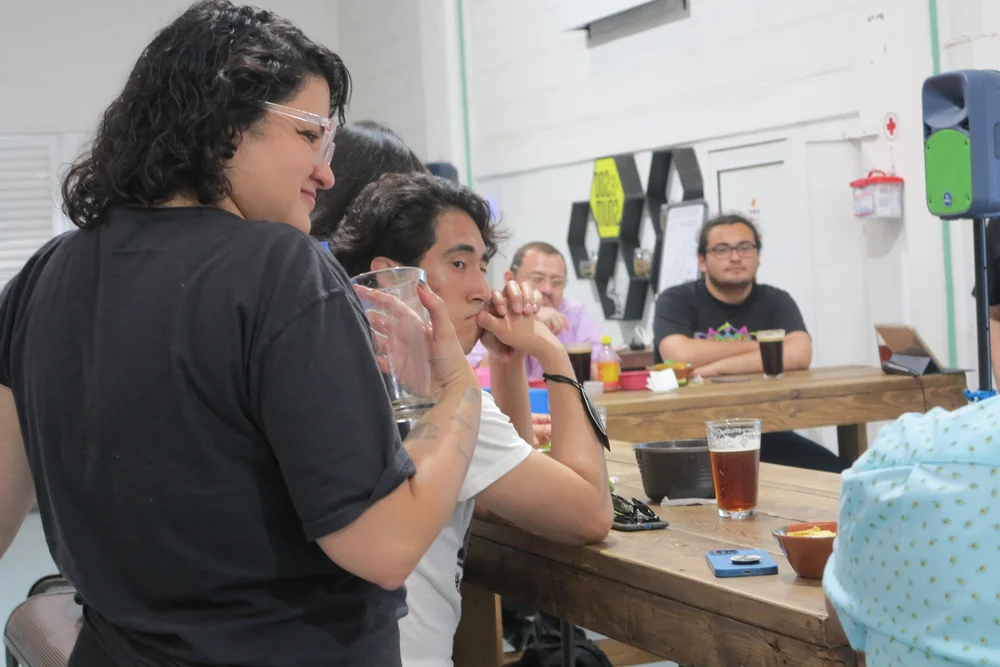When I arrive at Cervecería Dos Mundos, there is no indication that what stands behind the nondescript, unmarked metal door is a taproom. On this quiet, warehouse-lined Mexico City street, there’s a paper producer, a distribution center for Kellogg’s cereal, and a makeup company that started making hand sanitizer during the pandemic. Semi trucks sit outside of La Esperanza, one of Mexico’s largest bakeries. There’s also a factory that manufactures backpacks, and another that processes garlic, the smell of which occasionally wafts through the air. Further down the street, they sell car parts.

I text Rocio Gama, a staff member at the brewery: “I’m not sure if I’m at the right place.”
I’m sweating. On the two separate Metro lines I took to get here, I stood body-to-body with other commuters. Rather than taking a microbus or a motorized rickshaw to go the last mile or so, I walked, winding through the colorful streets of Iztapalapa. While much of this part of southeastern Mexico City is an industrialized gray, a recent community initiative has resulted in over 7,900 murals being painted throughout the borough.

But there is little shade. Further west, in Mexico City’s wealthier neighborhoods, the streets are tree-lined. Here, with a lack of green space and overabundance of pavement, the sun radidates.
I pull up Google Maps to triple-check that I’m in the right place. A second later, the brewery’s security guard unlocks the steel door and ushers me in.
A LONE TAPROOM
Dos Mundos, or Two Worlds, is the only taproom in Iztapalapa. The neighborhood is perhaps best known as “Mexico City’s most dangerous borough,” as it is often described, and it is home to some 2 million people. Until recently, it fell within the 10 most violent municipalities in the country. According to the United Nations Office on Drugs and Crime, 35% of borough residents live in poverty and less than half are formally employed. There are also 168 informal housing settlements, most of which lack access to basic resources. The population density in Iztapalapa is more than twice what it is in the rest of the city.

“Insecurity is an issue,” Iztapalapa resident and Dos Mundos regular Sergio Díaz Covarrubias tells me. “But it’s not as bad by the brewery as it is a few blocks away. And now, there are more streetlights, and transportation is improving. Security here is getting better.”
Streetlights, transportation, murals: These are all part of Iztapalapa Mayor Clara Brugada’s recent rehabilitation efforts. As part of the “Free and Safe Corridors for Women” initiative, bright solar lights and emergency buttons line the streets that were once considered the most dangerous in the city for women. A 6.5-mile cable car was installed in 2021 to allow residents of the borough’s steep hillsides to arrive more quickly at the city center, where most employment opportunities are. Where there was once only one swimming pool for the borough’s residents, there are now 15 sports and recreational facilities—called Utopias—constructed or in-process, all of which, in addition to pools, hold performance venues, athletic centers, artificial lakes, and skating rinks.
Inside the taproom, Dos Mundos’ co-founders, Caroline King and David Meza, are worried about water. Aside from personal safety, water might be the most talked-about topic in Iztapalapa. Here, regular water shortages result in mass demonstrations and the blockage of major roadways. Residents hijack water tankers and attack distribution depots, desperate to direct the resource to their homes and families. When there is water, what comes out of the tap is murky and black. “In this part, we don’t really have to deal with shortages. But we spend so much money on filters,” King sighs, “replacing our filters, cleaning our filters. At the moment, we change them weekly. It’s by far one of our largest expenses.”

Breweries are water-intensive projects. What’s it like, I want to ask King and Meza, to use so much water in an area known for not having it? But I realize the question is misdirected. In the wealthiest boroughs in the city, there is enough water not only to supply residents with a steady supply of the waning resource, but also to maintain the green sheen of several golf courses, to allow homeowners to water their lawns even as the dams dry up. My question should not be about a single brewery using too much water, but about who has access to it in the first place.

King and Meza met in Beijing in 2010. “We used to go to this brewery on one of these traditional streets in Beijing,” King says. “I can’t tell you what the beers were like or anything, but it had this great atmosphere and was just so much fun, so exciting.” The couple left China, eager to travel and develop a sense of how beer scenes were developing in different countries around the world. They ended up in Meza’s native Mexico in 2012 and started homebrewing. King, who’s from England, attributes the formula to homesickness. “I was starting to miss British beers, and beers imported from the U.K. to Mexico are so expensive, so we recreated beer in the British style,” she says.
At first, it was just for them. Meza and King made the beer they wanted to drink. There was no business plan, and they didn’t care if anyone else liked what they made. Soon, they started bringing beer to parties. Meza’s cousin requested a few kegs for her wedding. Eventually, they took a risk. “We never had any training in the world of brewing; we just traveled a lot,” says King. “Went to a lot of breweries, drank a lot.” In 2018, they officially opened the brewery in Iztapalapa, only about 10 minutes away from Meza’s childhood home. “The brewery is like a bridge between my childhood and adulthood,” he says.

Meza and his family have seen the neighborhood change over the decades. His mother, he tells me, lived in Iztapalapa when rivers flowed through it, when the area was dominated by wildlife and farmland. In the 1970s and ’80s, the population boomed. The borough grew informally, with the local government unable to keep pace with the city’s rapid expansion. There was little infrastructure and rampant state neglect. New highways cut through the borough, further separating it from the city center. “That’s when things grew more complicated,” Meza says. Now, he’s seeing a different kind of change. His brewery allows him to take part in it.
TWO WORLDS, ONE VISION
The couple developed a style of beer they define as British-Mexican, or as their name suggests, “Two Worlds.” They make beer inspired by British tradition, but tailor it to the climate and the type of beer most people in Mexico crave. Usually, these are Pilsners or Vienna-style Lagers, lightly flavored with low bitterness. “Sometimes, people ask for lime and salt,” King says, throwing up her hands. “You shouldn’t put lime and salt in this beer. We really try to discourage people from doing that.”

King is passionate about her product, defensive of British beer’s merit but without judgment for those who may not feel the same. I don’t tell her this, but cask real ale doesn’t necessarily sound very good to me. The industrial fan inside the brewery does little to cut through the heat, heavy with days of unwavering sun. I want a beer more chilled than it probably should be.
These brands are really well-received, and a lot of people are happy with that beer, so why change for something that’s twice the price? I mean, a lot of it does just come down to price. People do want to try it, but the price can be a little scary. It’s two to three times more.
“If people are used to drinking Victoria or something like that, we give them our Demiurgo Red Ale,” King says. It’s not a traditional Red Ale, and in some ways, it’s closer to an American Amber Ale, but the hops and malts are British. “Maybe it doesn’t fully fit the definition of a Red Ale,” King shrugs, “but it’s an Ale and it’s red.”
Those adaptations were necessary to help the beer find a local foothold. “Something super classic and super British wouldn’t sell,” she says. “But we knew there was a gap in the market for this kind of easy-drinking beer that was still interesting and told a story about the British tradition.”


Dos Mundos’ other offerings are similarly hybrid, eluding easy categorization. Its Porter, called Inframundo—meaning underworld, but as King explains, a sleek, mysterious underworld, not a scary one—is lighter and more refreshing than what many might expect from the style. “It’s got that chocolatey coffee, almost caramel notes to it,” King says. “But it’s not heavy. It’s not too sweet.”
For their IPA, the pair initially tried to brew according to a more British style, but it was easier to buy hops from the U.S. due to its proximity. “The perfect IPA doesn’t exist,” King says, “and we’re not going to make it. We will stay true to the style, take full advantage of international hops and malts, but try to make it very Mexican in the sense that it’s a beer Mexicans want to drink. Is it going to deviate from the style occasionally? Yes. Is it going to change and evolve over time? Absolutely. But it’s always going to be very easy-drinking and refreshing.” Fittingly, that IPA is called Entelequia: a person, place, or thing so perfect it only exists in the imagination.
THE STRUGGLE GAINS GROUND
In Mexico, mango season peaks in early summer. Throughout the city, vendors adorn the golden slices with chili and lime. Meza and King’s next goal is to capture this flavor, the delicate balance of sweet and tart, in a Mango Sour. They’re also beginning to stake out a partnership with an urban bee farm to make a Honey Ale.
“Did you tell her about the mushrooms?” Meza asks King, before being called over to one of the few occupied tables. Meza is quietly hospitable, humbly heeding the demands of a group of customers who yell his name from across the room. Sometimes, they want to order another beer. Other times, they have a story to tell him. He always obliges.

The mushrooms he’s referring to were partially produced by the brewery, in that they were nourished by its spent grain. Eventually, they will be used in the brewery’s four-course tasting menus (served with beer pairings), one of the events it has undertaken to get people interested in what it’s serving.
The story of craft beer in Mexico is one of ongoing struggle. While it is gaining ground, it still makes up less than 1% of the entire market, Meza and King tell me. Convincing people to try craft beer has been one of Dos Mundos’ biggest challenges. The big names in domestic beer, like Modelo Especial and Corona, almost all of which are owned by the U.S.-run Constellation Brands, still dominate the market. Small producers have long been effectively barred from competing, fighting for access to and space on supermarket and gas station shelves. Multinationals have the capacity and economies of scale to sell their products at considerably lower price points.
It’s very significant. For us, it’s a little bit different to drink beer in the same place where you make it. There are bars where you can have a beer, or a pulque, but you don’t really see anything else like Dos Mundos in the area.
“These brands are really well-received, and a lot of people are happy with that beer, so why change for something that’s twice the price?” King says. “I mean, a lot of it does just come down to price. People do want to try it, but the price can be a little scary. It’s two to three times more.”
In the central parts of Mexico City, it’s no longer hard to find craft beer. But it is hard to find a craft beer under 100 pesos (about $5). A domestic beer is less than half that, at about 25 to 35 pesos. It’s also challenging in Mexico to get the equipment and ingredients needed to make a high-quality beer. The country doesn’t produce hops, and its barley is not ideal for brewing. Plus, taxes are steep, making up nearly half of what the business earns.

Dos Mundos’ prices are more accessible, at 60 pesos for a 12oz glass. This gives people the opportunity to try craft beer who otherwise might not have the opportunity to do so. Zosim Silva, a regular customer at the brewery, discovered Dos Mundos because the larger breweries (or “los macros”) were suffering from pandemic-related shortages. Vendors started raising their prices, so Silva searched for beer on Google Maps. In much the way I did, he came upon Dos Mundos’ unmarked door and knocked. Meza let him in and, although the brewery was only open for carryout at the time, explained a little bit about their beer and the process behind it.
“It’s very significant,” Silva says. “For us, it’s a little bit different to drink beer in the same place where you make it. There are bars where you can have a beer, or a pulque, but you don’t really see anything else like Dos Mundos in the area.”


Beer in Mexico, Silva tells me, has always been intertwined with class. Pulque, which is made from fermented maguey agave sap and has pre-Hispanic origins, was once the drink of the working class, while beer was reserved for the elite. This all changed when former dictator President Porfirio Díaz, who came to power in 1877, started calling for foreign investment. It was then that beer in Mexico started to take off. Multinational beer companies tried to destroy pulque, their main competition, spreading rumors about its ill repute and supposed backwardness. While pulque is still enjoyed throughout central Mexico, today beer is more commonly consumed, with Mexico now the sixth-highest beer-consuming country in the world. Now, it’s no longer associated with the elite. Instead, domestic beer, despite being produced by multibillion-dollar international companies, has come to represent a certain working-class, communal ethic. Consumers can buy a 1.2-liter bottle from a corner store for less than $3 and share it among friends.

Breweries like Dos Mundos might be helping to shed craft beer’s reputation as reserved only for the well-to-do. The lower price point helps, but they have also worked to make the space accessible and welcoming to those who might not (yet) know much about beer.
“Drinking beer from Dos Mundos is a little more work,” Silva continues. “Not because of the flavor, but because a lot of people are accustomed to having a beer that is really easy to drink, like Corona or Victoria, something refreshing and uncomplicated.”
THE CITY’S MAIN VEIN
Most taprooms, and most bars that sell craft beer, are relegated to a few wealthy and tourist- or expat-heavy areas closer to the city’s center. Mexico City’s status as an “it” destination largely revolves around the Cuauhtémoc borough, which holds most of the city’s fine dining restaurants, museums, and hotels. Recently, remote workers have (temporarily or permanently) made Mexico City their base. But, as residents complain, because tourist and expat presence is largely constrained to the city center, their understanding of the city is limited, and their “valued dollars” are stuck in a single high-end loop in what are already the most prosperous neighborhoods. This has led to a series of articles condemning such behavior, decrying rising housing prices and the propensity for visitors and expats alike to say “I love Mexico City” without really knowing anything about it. For one commenter on an article about the problem, the brewery’s neighborhood served as a punchline. “So what do you expect them to do? Go to Iztapalapa?”

“Yes,” King, Meza, and Gama all agree. “You can’t make assumptions about a place as big as Iztapalapa,” Gama says. “It’s like an entire city in and of itself.”
Beyond being Mexico City’s largest borough, Iztapalapa is its beating heart. Everyday, metros and buses and the sweeping cable car bring the bulk of the city’s workforce to the center. Transportation from the area is, as Silva says, “the main veins to the city’s body.”
About a 20-minute walk from Dos Mundos is the Central de Abasto, which is among the largest wholesale markets in the world. Nearly all of the food served in Mexico City’s restaurants passes through it: Produce is stacked piles high, with entire sections dedicated to a single product. There is one warehouse or more each dedicated to fruits, vegetables, flowers, meat, poultry, and fish. “Plus,” Gama tells me, “the food there is the best in all of Mexico City.”
You can’t make assumptions about a place as big as Iztapalapa. It’s like an entire city in and of itself.
When the brewery opened in 2019, King and Meza gradually became a part of the surrounding community. “2019 was like a baptism of fire for us,” King says. “We didn’t make much money but we learned a lot.” They started experimenting with new flavors, releasing specials every month. Workers from the nearby factories, curious about what lay behind the closed door, started poking their heads in, stopping by for a beer after work. On the weekends, they would bring their families.
“We started 2020 with so much enthusiasm. We held a couple of really great events here at the beginning of 2020,” King trails off, understanding that I already know, as everyone always knows, the inevitable end to that sentence: But then COVID happened. Mexico was among the hardest-hit countries in the world, with nearly 7 million recorded cases and a death count believed to be only about one-third of the true total. Iztapalapa was one of the municipalities that suffered the most. The factory workers were laid off. King and Meza continued going into the brewery to make beer to be sold to-go. While they kept their staff employed, they didn’t ask them to come in. “We couldn’t make them use public transportation,” King says. The federal government gave them a single small business loan of $1,000.

Today, it looks like the brewery is making a comeback. Dos Mundos is holding one of its now-monthly “FiloChela” events (from filo, meaning philosophy, and chela, a slang word for beer). Alejandro Vázquez del Mercado Hernández, a philosophy professor at the National Autonomous University of Mexico, and Azucena Palavicini Sánchez, a philosophy professor at Monterrey Tech’s Mexico City campus, prepare lectures and hold a discussion with participants on different topics. Today’s issue is “Can you find happiness without love?”
Palavicini Sánchez and Vázquez del Mercado Hernández emphasize that the events are not academic in the traditional sense. Instead, they serve as a bridge between academia and the general public. FiloChela, they say, is a space for reflection and diversity of thought. “People can feel intimidated by academic topics, if they think they need to prepare, or if they’re worried about how they’re going to sound,” Palavicini Sánchez says. “But what’s more casual than having a beer?”


“I love it,” adds Manuel Ramón Dzul Chiquini, a frequent FiloChela participant whom the students in attendance all call Dad. “It gives me the chance to spend time with young people, to hear opinions I wouldn’t otherwise be exposed to.”
The sidewalk in front of the brewery, which was empty when I arrived, is now full of young people smoking cigarettes. Before the lecture begins, Meza and King fill bowls with chicharrones de harina, traditional cantina snacks of fried wheat served alongside lime wedges and bottles of Victoria hot sauce. The crowd’s enthusiasm is obvious from the start. What is intended as an icebreaker, asking patrons to share what they define as love and happiness, turns into a series of individual lectures, a smattering of meaningful moments presented as anecdotes in front of the audience. Palavicini Sánchez and Vázquez del Mercado Hernández finally recover the mic, delving into the PowerPoint presentation they prepared for the occasion. On some slides, they share data quantifying the seemingly unquantifiable, the numbers giving concrete definition to subjects that only a moment before were personal and abstract.


Participants vie for the mic, getting up out of their chairs and ignoring the hierarchy of hand-raising. Nobody diverts their attention to order more beer, instead holding up one or two fingers to indicate that their glasses need refilling. Somehow, Meza and King remember what everyone is drinking. Occasionally, the professors deviate from their academic role to help serve, refilling snack bowls and tossing empty bottles of hot sauce. The event, scheduled for two hours, lasts nearly five.
While the discussion is heated, it isn’t antagonistic. Almost everyone seems to agree that happiness and love are undefinable, but that such emotions are deeply intertwined with having our basic needs met. It is harder to be happy while facing insecurity or economic precarity. It’s an apt discussion, taking place in a brewery situated in a borough that has long suffered from violence and an absence of resources. Craft beer may not be essential to one’s happiness, but access to a safe space in which to gather and celebrate is.
SAFE AND WELL-BEHAVED
Creating a sense of safety is, unsurprisingly, central to Dos Mundos’ ethos. “We’re a safe place to bring families, or even well-behaved dogs,” King says. They’ve paid for Ubers for young women who are reluctant to walk home. Each time I leave, they walk me to the corner of the block or wait with me until my cab arrives. But really, I don’t think they need to. Kids play soccer outside, the solar lights serving as goal posts. A couple leans against a mural decorated with images of Aztec gods. A woman passes, walking alone. Despite the improving atmosphere, just 20% of Iztapalapa residents report feeling safe. It’s a bleak figure. But a few years ago, that number was only about 7%.

During my visits to Dos Mundos, there are academics, students, factory workers, a writer, and a mathematician in attendance. “Outside of the city center there are all of these other cultural sites, these bars where cultural revolutions happen, where there are political movements and discussions,” Silva says. “These nucleuses outside of Cuauhtémoc where the political decisions are made, they are also important.
“Places like this,” he continues, “can generate change, above all.”

King and Meza will continue serving good beer, colder than King would probably like it, behind a heavy, unmarked door. They will experiment with ingredients like mango and honey and come up with something nobody has ever seen before. Maybe a brewery isn’t going to save anyone. It might not make the neighborhood safer, or get anyone closer to having their basic needs met. But if those who frequent Dos Mundos have decided that it is going to play a role in how their neighborhood is shaped, then that’s the direction it’s going to go in. The revolution will not be won in a brewery, but it might just be started within one. And King and Meza will be there, serving beer and occasional bar snacks.


